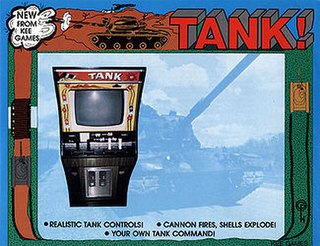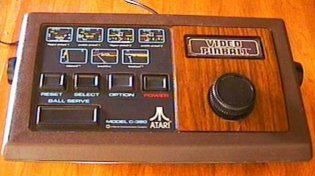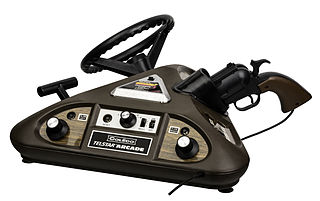
Pong is a table tennis–themed arcade sports video game, featuring simple two-dimensional graphics, manufactured by Atari and originally released in 1972. It was one of the earliest arcade video games; it was created by Allan Alcorn as a training exercise assigned to him by Atari co-founder Nolan Bushnell, but Bushnell and Atari co-founder Ted Dabney were surprised by the quality of Alcorn's work and decided to manufacture the game. Bushnell based the game's concept on an electronic ping-pong game included in the Magnavox Odyssey, the first home video game console. In response, Magnavox later sued Atari for patent infringement.

The Magnavox Odyssey is the first commercial home video game console. The hardware was designed by a small team led by Ralph H. Baer at Sanders Associates, while Magnavox completed development and released it in the United States in September 1972 and overseas the following year. The Odyssey consists of a white, black, and brown box that connects to a television set, and two rectangular controllers attached by wires. It is capable of displaying three square dots and one line of varying height on the screen in monochrome black and white, with differing behavior for the dots depending on the game played. Players place plastic overlays on the screen to display additional visual elements for each game, and the one or two players for each game control their dots with the knobs and buttons on the controller in accordance with the rules given for the game. The console cannot generate audio or track scores. The Odyssey console came packaged with dice, paper money, and other board game paraphernalia to accompany the games, while a peripheral controller—the first video game light gun—was sold separately.

Breakout is an arcade game developed and published by Atari, Inc., and released on May 13, 1976. It was conceptualized by Nolan Bushnell and Steve Bristow, influenced by the seminal 1972 Atari arcade game Pong. In Breakout, a layer of bricks lines the top third of the screen and the goal is to destroy them all by repeatedly bouncing a ball off a paddle into them. The arcade game was released in Japan by Namco. An Atari VCS port was released in 1978 which used color graphics instead of a monochrome screen with a colored overlay.

Combat is a video game by Atari, Inc. for the Atari Video Computer System. It was one of the nine launch titles for the VCS in September 1977 and was included in the box with the system from its introduction until 1982. Combat is based on two earlier black-and-white coin-operated arcade video games produced by Atari: Tank in 1974 and Jet Fighter in 1975. Combat was programmed by Joe Decuir and Larry Wagner.

Tomohiro Nishikado is a Japanese video game developer and engineer. He is best known as the creator of the arcade shooter game Space Invaders, released to the public in 1978 by the Taito of Japan, often credited as the first shoot 'em up and for beginning the golden age of video arcade games. Originally Nishikado wanted to use airplanes as enemies for Space Invaders, but would have encountered problems making them move smoothly due to the limited computing power at the time. Humans would have been easier to render, but management at Taito forbade the use of human targets.
1980 saw the release of a number of games with influential concepts, including Pac-Man, Battlezone, Crazy Climber, Mystery House, Missile Command, Phoenix, Rally-X, Space Panic, Stratovox, Zork, and Olympic Decathlon. The Atari VCS grew in popularity with a port of Space Invaders and support from new developer Activision.
1975 has several new titles such as Western Gun, Dungeon and dnd.
An electronic game is any game that employs electronics to create an interactive system with which a player can play. Video games are the most common form today, and for this reason the two terms are often used interchangeably. There are other common forms of electronic game including handheld electronic games, standalone systems, and exclusively non-visual products.
A dedicated console is a video game console that is limited to one or more built-in video game or games, and is not equipped for additional games that are distributed via ROM cartridges, discs, downloads or other digital media. Dedicated consoles were very popular in the first generation of video game consoles until they were gradually replaced by second-generation video game consoles that use ROM cartridges.

The Color TV-Game is a series of five dedicated home video game consoles created by Nintendo that were released in Japan only. Nintendo sold three million units of the first four models: one million units of each of the first two models, Color TV-Game 6 and 15; and half a million units of each of the next two models, Block Breaker and Racing 112. The Color TV-Game series has the highest sales figures of all the first generation of video game consoles. The systems can run on C batteries or an AC adapter. It is also the first console to be released by Nintendo.

The ColecoTelstar Marksman, commonly abbreviated as Telstar Marksman, is a first-generation home video game console that featured a light gun. It was released by Coleco in 1978. Because it had a manufacturer-set number of games, it is considered a dedicated console. It was part of the Coleco Telstar series Pong-based home video game consoles; it is essentially a Coleco Telstar Colortron bundled with a "3 in 1" light gun and two shooting games. The Marksman light gun is a pistol that features an attachable stock and barrel. It is similar in this regard to the later-released Stack Light Rifle and the Sega Menacer. The elongated barrel included a simple aiming sight. In addition to the light gun, the system featured two paddle controllers built directly into the console. Its reported features included "on-screen digital scoring" and three different difficulty settings. It required two nine-volt batteries or Coleco's Perma Power AC adaptor to power the system.

Tank is an arcade game developed by Kee Games, a subsidiary of Atari, and released in November 1974. It was the only original title not based on an existing Atari property developed by Kee Games, which was founded to sell clones of Atari games to distributors as a fake competitor prior to the merger of the two companies. In the game, two players drive tanks through a maze viewed from above while attempting to shoot each other and avoid mines, represented by X marks, in a central minefield. Each player controls their tank with a pair of joysticks, moving them forwards and back to drive, reverse, and steer, and firing shells with a button to attempt to destroy the other tank. The destruction of a tank from a mine or shell earns the opposing player a point, and tanks reappear after being destroyed. The winner is the player with more points when time runs out, with each game typically one or two minutes long.
In the history of video games, the first-generation era refers to the video games, video game consoles, and handheld video game consoles available from 1972 to 1983. Notable consoles of the first generation include the Odyssey series, the Atari Home Pong, the Coleco Telstar series and the Color TV-Game series. The generation ended with the Computer TV-Game in 1980, but many manufacturers had left the market prior due to the market decline in 1977 and the start of the second generation of video game consoles.

The Video Pinball brand is a series of first-generation single-player dedicated home video game consoles manufactured, released and marketed by Atari, Inc. starting in 1977. Bumper controllers on the sides or a dial on the front are used to control the games depending on the game selected. There are three game types in the first model of the Video Pinball series: Pinball, Basketball, and Breakout.

Atari, Inc. was an American video game developer and home computer company founded in 1972 by Nolan Bushnell and Ted Dabney. Atari was responsible for the formation of the video arcade and modern video game industry.
Unisonic Products Corporation was an American manufacturer and distributor of consumer electronics from the 1970s to the 1990s. Although headquartered in New York City, Unisonic outsourced its manufacturing operations to various facilities in East Asia. Unisonic developed a variety of electronics, including calculators, CRT television sets, video game consoles, digital watches, telephones, answering machines, and digital alarm clocks.

The Fairchild Channel F is a home video game console released by Fairchild Camera and Instrument in November 1976. It has the distinction of being the first programmable ROM cartridge–based video game console, and the first console to use a microprocessor. It was launched as the Fairchild Video Entertainment System, or Fairchild VES for short, but when Atari released their Atari Video Computer System, Atari VCS, later Atari 2600 the next year, Fairchild renamed its machine.

The 1970s was the first decade in the history of the video game industry. The 1970s saw the development of some of the earliest video games, chiefly in the arcade game industry, but also several for the earliest video game consoles and personal computers.

The Coleco Telstar Arcade, commonly abbreviated as Telstar Arcade, is a first-generation home video game console that was released in 1977 in Japan, North America and Europe by Coleco. It is the most advanced video game console in the Coleco Telstar series, based on the MOS Technology MPS-7600-00x chips series. Each of these chips is a full microcontroller with 512 ROM area.













